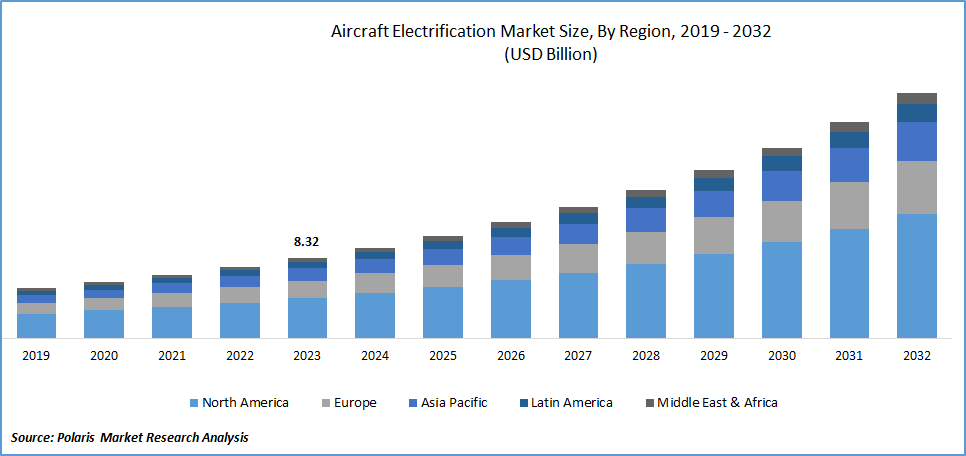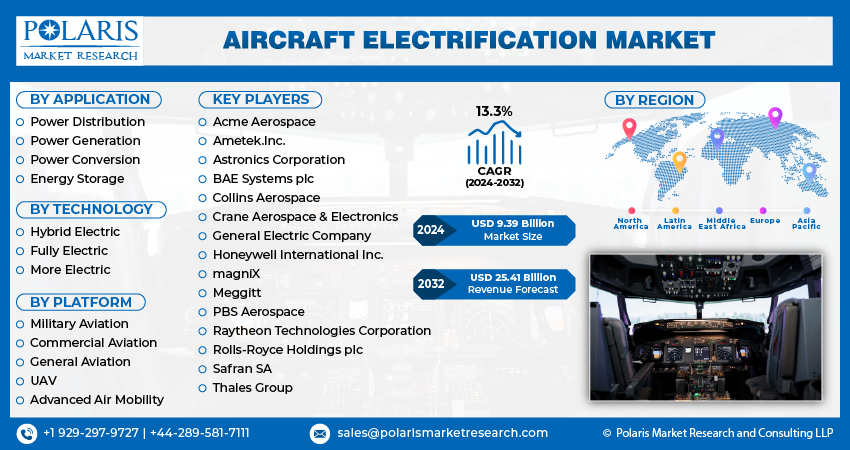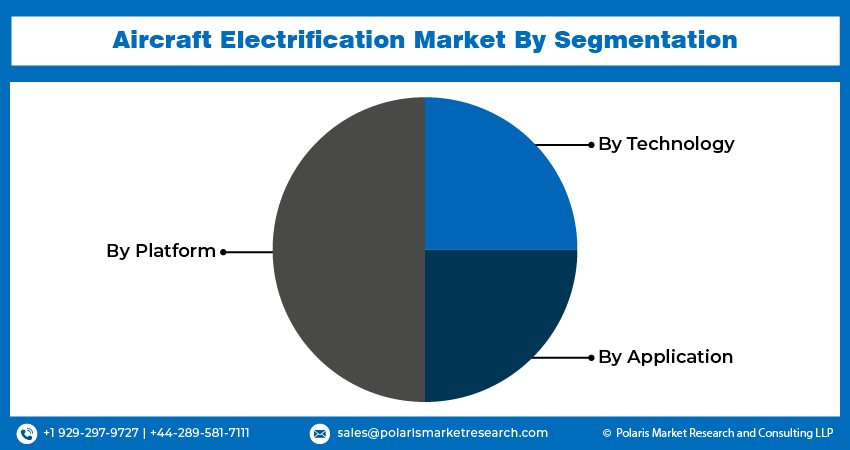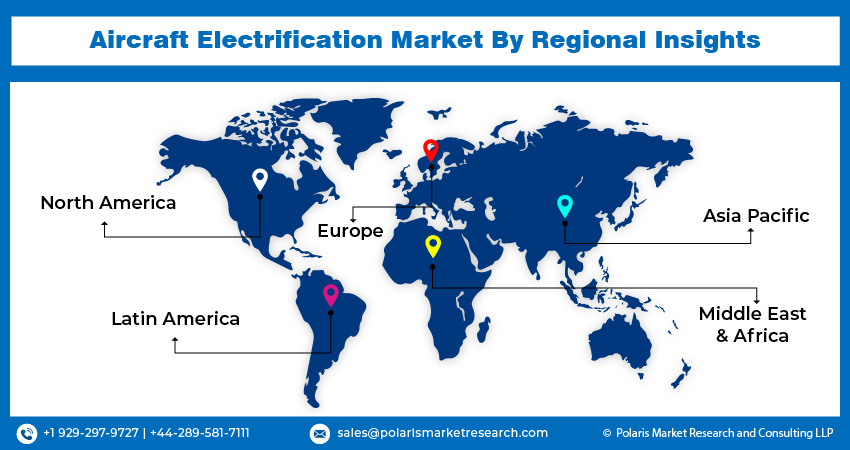
Aircraft Electrification Market Share, Size, Trends, Industry Analysis Report, By Application (Power Distribution, Power Generation, Power Conversion, Energy Storage); By Technology; By Platform; By Region; Segment Forecast, 2024 - 2032
- Published Date:Feb-2024
- Pages: 119
- Format: PDF
- Report ID: PM4373
- Base Year: 2023
- Historical Data: 2019-2022
Report Outlook
The global aircraft electrification market was valued at USD 8.32 billion in 2023 and is expected to grow at a CAGR of 13.3% during the forecast period.
Reduced operating costs constitute a compelling factor driving the aircraft electrification market. Electric aircraft promise significant economic advantages stemming from lower maintenance requirements, decreased reliance on intricate mechanical components, and the diminishing cost of electricity compared to traditional fuel. This operational cost efficiency is a key motivator for airlines and operators to transition toward electric propulsion systems. With fewer moving parts and simplified maintenance protocols, electric aircraft present a transformative opportunity for the aviation industry to achieve tangible economic benefits while embracing sustainable and efficient air travel.
In addition, companies operating in the market are investing in research and development to introduce advanced solutions and strengthen market presence.

To Understand More About this Research: Request a Free Sample Report
- For instance, in June 2023, Airbus and STMicroelectronics signed a collaborative agreement to engage in joint Research & Development efforts focused on advancing power electronics. The primary objective is to enhance the efficiency and reduce the weight of power electronics, which holds crucial significance for the development of future hybrid-powered aircraft and fully electric urban air vehicles.
Regulatory initiatives play a pivotal role in steering the aircraft electrification market towards a sustainable future. Stringent environmental regulations and emission standards imposed by aviation authorities globally act as compelling catalysts. The aviation industry is propelled to embrace cleaner technologies to meet evolving regulatory benchmarks. Commitment to reducing carbon emissions aligns with these initiatives, driving substantial investments and research in electric propulsion systems. Regulatory support creates a conducive environment, fostering collaboration and innovation, thereby accelerating the integration of electrification technologies into aircraft design and operations to ensure compliance with the dynamic regulatory landscape.
The aircraft electrification market is marked by a surge in investments directed towards innovative startups. Increasingly, venture capital funding is flowing into electric aviation ventures, driving research and development. Startups with a focus on pioneering electric propulsion technologies are reshaping the industry landscape. These investments foster a dynamic ecosystem of innovation, attracting talent and expertise to address the challenges of electric aircraft development. Collaborations between startups and established industry players amplify the momentum, creating opportunities for breakthroughs in electric aviation. This infusion of capital and collaboration accelerates the market's evolution towards sustainable and efficient electric air transportation.

Industry Dynamics
Growth Drivers
Growing environmental concerns and advancements in battery technology
The aircraft electrification market is driven by a central focus on environmental sustainability. On a global scale, there is a dedicated commitment to curbing aviation emissions and addressing climate change, leading the industry to adopt electric propulsion systems increasingly. Electrification serves as a more environmentally friendly and cleaner substitute for conventional aviation, aligning seamlessly with strict environmental regulations and emission standards. As the demand for eco-conscious transportation solutions gains momentum, the aviation sector places a heightened emphasis on sustainable practices, positioning aircraft electrification as a crucial element in reducing its carbon footprint. This commitment to environmental responsibility acts as a dynamic force, spurring advancements and investments for a more sustainable future in air travel.
Progress in battery technology is fundamentally restructuring the landscape of the aircraft electrification sector. The creation of high-energy-density batteries stands out as a central catalyst, altering the practicality and effectiveness of electric aircraft. These batteries, distinguished by their enhanced energy storage capacities, overcome historical constraints and enhance the distances electric aircraft can cover. Lithium-ion batteries and emerging chemical compositions contribute to the development of lightweight, high-performance solutions indispensable for electric aviation. As battery technology undergoes continuous refinement, it not only amplifies the operational capabilities of electric aircraft but also expedites the industry's shift toward more sustainable, energy-efficient, and extended-range electric air transportation.
Report Segmentation
The market is primarily segmented based on application, technology, platform, and region.
|
By Application |
By Technology |
By Platform |
By Region |
|
|
|
|
To Understand the Scope of this Report: Speak to Analyst
By Application Analysis
The power distribution segment accounted for a significant market share in 2023.
The power distribution segment accounted for a significant market share in 2023. Aircraft electrification revolutionizes aviation with the implementation of integrated power distribution systems. This transformative shift replaces traditional mechanical and hydraulic systems with sophisticated electrical architectures. Integrated power distribution systems efficiently manage and distribute electrical power throughout the aircraft, optimizing performance and reliability. This shift towards comprehensive electrification contributes to weight reduction, increased efficiency, and sustainability.
By Technology Analysis
The hybrid electric segment is expected to experience significant growth during the forecast period
The hybrid electric segment is expected to experience significant growth during the forecast period. Hybrid aircraft electrification integrates traditional combustion engines with electric propulsion, optimizing fuel efficiency and reducing emissions. This dual-power approach, fostering increased efficiency and extended range, is adaptable to emerging electric technologies. Regenerative energy capture and flexible power management enhance overall performance. Hybrid configurations contribute to noise reduction during takeoff and landing, addressing environmental concerns. Their adaptability serves as a transitional step toward full electrification, allowing the industry to gain experience with electric technologies.
By Platform Analysis
The UAV segment accounted for the largest market share in 2023
The UAV segment accounted for the largest market share in 2023. Electric propulsion systems, powered by batteries or fuel cells, enhance endurance and range, reduce environmental impact, and provide modular design options. Electric UAVs operate silently, offering precision control, rapid response, and enhanced agility for applications such as surveillance and reconnaissance. Integration of hybrid systems and advancements in battery technology contribute to efficiency. Electric UAVs find diverse applications, from agriculture to defense, and autonomous operations are facilitated. The development of charging infrastructure supports the widespread deployment of these sustainable and versatile unmanned aerial systems.

Regional Analysis
North America accounted for the largest revenue share in 2023
North America accounted for the largest market revenue share. Within North America, major players in the aerospace sector, including industry giants such as Boeing and Airbus North America, are deeply immersed in robust research and development initiatives. Their primary focus extends towards hybrid and electric propulsion systems, aiming to amplify fuel efficiency and curtail the environmental impact of aviation. The region is witnessing the emergence of startups and innovative entrants dedicated to the vision of electric aviation. These dynamic companies stand at the forefront of pioneering cutting-edge technologies for electric vertical takeoff and landing aircraft, urban air mobility solutions, and short-haul electric aviation. Research and development endeavors are propelling the industry, particularly in refining battery technologies and electric propulsion systems and optimizing aircraft design for peak efficiency. Collaborative projects involving industry leaders, government agencies, and esteemed research institutions are steering technological advancements.

Key Market Players & Competitive Insight
The market faces fierce rivalry, with companies leveraging cutting-edge technology, top-notch product offerings, and a robust brand reputation to propel revenue expansion. Key players employ diverse tactics, including dedicated research and development, strategic mergers and acquisitions, and continuous technological advancements. These strategic maneuvers are aimed at broadening their product ranges and sustaining a competitive advantage. The market dynamic is shaped by constant innovation and a commitment to delivering high-quality solutions, underscoring the importance of strategic initiatives in ensuring sustained competitiveness.
Some of the major players operating in the global market include:
- Acme Aerospace
- Ametek.Inc.
- Astronics Corporation
- BAE Systems plc
- Collins Aerospace
- Crane Aerospace & Electronics
- General Electric Company
- Honeywell International Inc.
- magniX
- Meggitt
- PBS Aerospace
- Raytheon Technologies Corporation
- Rolls-Royce Holdings plc
- Safran SA
- Thales Group
Recent Developments
- In January 2024, Surf Air Mobility entered into agreements to supply its technology to two operators in Kenya. Both Safarilink and Yellow Wings have committed to incorporating SAM's exclusive powertrain once it receives FAA certification, which is anticipated in 2026.
- In November 2022, Airbus and Renault Group entered into a research and development agreement with the goal of boosting cross-functional collaboration and synergies to expedite the electrification plans of both companies, thereby enhancing their product portfolios. This partnership is set to facilitate the advancement of technologies related to the future electrification of hybrid aircraft for Airbus.
Aircraft Electrification Market Report Scope
|
Report Attributes |
Details |
|
Market size value in 2024 |
USD 9.39 billion |
|
Revenue forecast in 2032 |
USD 25.41 billion |
|
CAGR |
13.3% from 2024 - 2032 |
|
Base year |
2023 |
|
Historical data |
2019 - 2022 |
|
Forecast period |
2024 - 2032 |
|
Quantitative units |
Revenue in USD million/billion and CAGR from 2024 to 2032 |
|
Segments covered |
By Application, By Technology, By Platform, By Region |
|
Regional scope |
North America, Europe, Asia Pacific, Latin America; Middle East & Africa |
|
Customization |
Report customization as per your requirements with respect to countries, region and segmentation. |
FAQ's
The Aircraft Electrification Market report covering key segments are application, technology, platform, and region
The global aircraft electrification market size is expected to reach USD 25.41 billion by 2032
The global aircraft electrification market is expected to grow at a CAGR of 13.3% during the forecast period.
North America regions is leading the global market.
Growing environmental concerns are the key driving factors in Aircraft Electrification Market.
